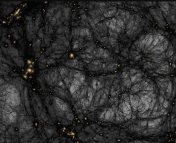Title: Searching for a subpopulation of primordial black holes in LIGO/Virgo gravitational-wave data
Authors: Gabriele Franciolini, Vishal Baibhav, Valerio De Luca, Ken K. Y. Ng, Kaze W. K. Wong, Emanuele Berti, Paolo Pani, Antonio Riotto, and Salvatore Vitale
First Authors’ Institution: Département de Physique Théorique and Centre for Astroparticle Physics (CAP), Université de Genève, Geneva, Switzerland; Dipartimento di Fisica, Sapienza Università di Roma, Roma, Italy
Status: Published in APS Phys Rev D, open access
Over the past few years, the LIGO–Virgo–Kagra (LVK) collaboration has detected over 90 signals from merging binary black holes (BBHs) and neutron stars (collectively referred to as compact objects) from tiny spacetime wiggles, called gravitational waves (GWs). One big question GW astronomers have is how do these binary compact objects form, and where do they come from.
So what do we know so far?
The key understanding is that the main contributors to the detected population of merging compact objects are massive binary stars which collapse into black holes and neutron stars at the end of their lives. One of the detected GW signals, GW190521, throws a wrench in this process. Our current theories of stellar evolution say that there is a maximum possible mass for black holes born from collapsing massive stars. However, the widely agreed interpretation of this signal implies a merger event of two black holes that are more massive than this limit.
On the other hand, astronomers have been gathering evidence for the existence of primordial black holes (PBHs), which didn’t collapse from dying stars but instead formed from especially overdense regions at the very beginning of the universe. The authors of today’s paper invoke a population of PBH binaries as a means to explain this outlier. They use historical GW data to see if we can detect a trace of this PBH population to overcome the stellar evolution bottleneck, as well as compare the relative abundance of PBHs compared to other stellar GW formation pathways.
Starting with the non-primordial binaries
Today’s paper takes the models from some previous works, which focused on different evolutionary channels, not including the PBH channel. These models were made up of two ‘isolated’ channels where the stars are born together, grow old, and die together in a beautiful marriage; and two ‘dynamical’ channels, where compact objects fly about all over the place, and at some point come close enough to gravitationally capture each other. Artificial populations of these channels are constructed, and the stellar evolution processes for each channel are simulated, and then study the resulting population of black hole binaries that we could detect with GW observatories. The isolated sub-channels include:
- stable mass transfer (SMT), where stable accretion of matter from one object to the other brings the stars closer together.
- common envelope (CE), where stars are so close that the mass transfer is unstable, and the outer layers of the massive star get wrapped into a cosy envelope of gas around the pair. The stars orbiting in the envelope transfer angular momentum to it, expelling it away; the stars themselves then lose angular momentum and orbit closer together.
The two dynamical environments modelled are globular clusters (GC), old dense conglomerates of stars on the outer edges of galaxies, and nuclear star clusters (NSC), dense regions in the centre of galaxies.

Adding in Primordial Black Holes
Today’s paper compares the above to an additional formation channel, the primordial black holes, which are modelled according to certain parameters, such as the PBH mass distribution, their abundance in the universe, and the age until which they grew. The paper adds to the previous work by modelling the survival of the PBH binary population and calculating the merger rates.
The authors then compare these now 5 simulated populations to a catalogue of GW events and find the branching fractions — what percentage of sources we would detect from each channel — for CE+GC+NSC+PBH and CE+GC+SMT+PBH combinations of channels:
Results

The results show the reduced chirp mass of the binaries versus the fractional contribution of each of the channels (different coloured lines) to the total mass distribution – what fraction of detections are made at each chirp mass (thick black line). The contributing fraction of the PBH channel depends on which other channels are included in the model, and if the SMT channel isn’t taken into account, the PBH channel has the largest contribution than any other channel above ~25 solar masses, as shown in the left plot of Figure 2. When the SMT channel is included, as shown on the right plot of Figure 2, the PBH contribution is low apart from at the very highest masses, where it is the dominant contribution. Therefore, the PBH channel can efficiently produce binaries as massive as the one observed in GW190521, while the other channels can’t reach these high masses.
However, this isn’t necessarily proof that GW190521, or other future massive events, come from PBHs. In fact, this paper finds that certain combinations of formation channels can account for all catalogue events except GW190521. However, there are other hypotheses that could account for black holes this massive. For example, other exotic environments could give rise to strangely massive BBHs, such as BBHs which form in AGN accretion disks.
Conclusive answers on an underlying population of PBH binaries could come when new GW detectors such as the Einstein Telescope and Cosmic Explorer come online in the coming decades, which will be sensitive enough to detect black holes chirping at the very start of the universe.
Astrobite edited by Sonja Panjkov, Sabina Sagynbayeva
Featured image credit: Modified from Klaus Nielsen




